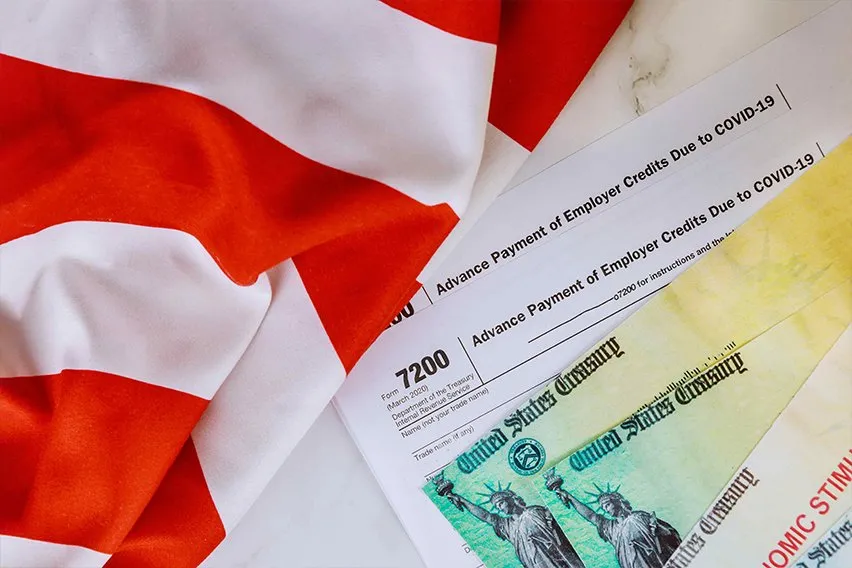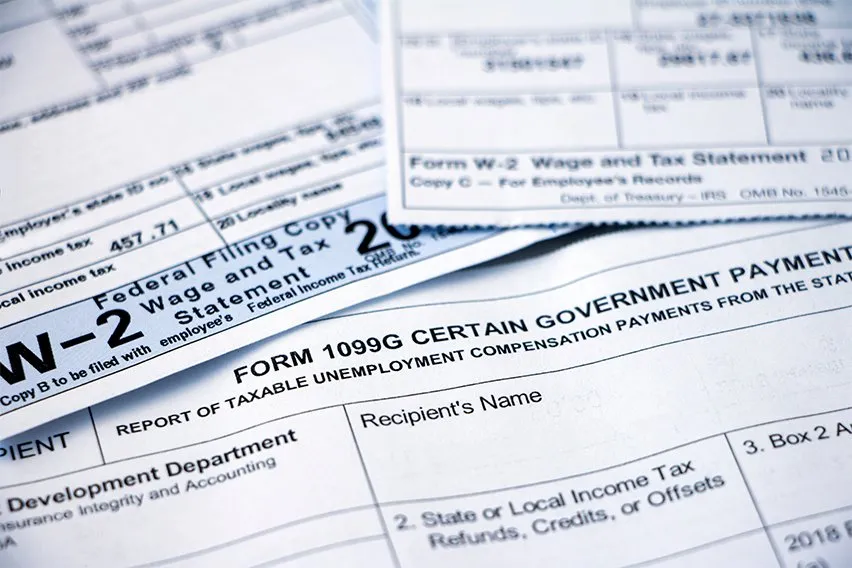IRS Form 7200: A Detailed Explanation Guide

To provide relief for businesses affected by the pandemic, the federal government introduced The Coronavirus Aid, Relief, and Economic Security (CARES) Act and Families First Coronavirus Response Act (PL 116-127; FFCRA). Both laws help companies to claim advance employer credits on tax returns using an IRS Form 7200.
This article will explain the form 7200 instructions and how they apply to your small business. Please note that the last day to file Form 7200 was January 31, 2022. Form 7200 is no longer accepted in 2024.
Here’s What We’ll Cover:
Who Can File For Advanced Tax Credits?
What is the Deadline for Filing Form 7200?
How Long Does It Take to Process Advanced Tax Credit Applications?
How to Complete Your IRS Form 7200: Instructions
What Common Errors Should I Avoid When Filling My Form 7200?
More Tax Resources for Businesses
What is an IRS Form 7200?
Form 7200 allows eligible employers to request advance payment of employee retention credit from the IRS. It covers claims on different types of employment tax returns, including Form 941, quarterly employment tax, as well as employer relief credits on qualified paid sick or family leave, and/or the COBRA premium assistance credit. For the employee retention credit, the advance payment requested may not exceed 70% of the average quarterly wages paid by the employer in calendar year 2019. This limitation helps manage the size of the advance credit, ensuring it is in line with the employer’s wages during the reference period.
For example, an employer has a total retention tax deposit required of $10,000. They are entitled to $8,000 in credits. This means the employer would only need to deposit $2,000 on the next regular deposit date.

Who Can File For Advanced Tax Credits?
Employers who meet the CARES and FFCRA requirements are eligible for advanced tax credits.
Other things you should know include
- Small businesses (less than 500 employees) qualify for FFCRA credits as long as they provide paid sick and family leave for their employees.
- Eligible employers can only request advanced credits if their reduced 941 tax deposits do not cover the costs of qualified sick and family leave payments and retention tax credits.
- Self-employed individuals and government employers cannot file Form 7200.
- Business owners who have submitted Form 941 for a quarter cannot request advance payment of refundable tax credits in the same quarter.
What is the Deadline for Filing Form 7200?
Business owners can file for anticipated credit anytime within the month following the quarter in which they paid the qualified wages. However, the following deadlines apply;
- August 2, 2021, for qualified wages paid in the second quarter of 2021.
- November 1, 2021, for qualified wages paid in the third quarter of 2021.
- The last day to file form 7200 to request an advance employment tax return for the fourth quarter of 2021 is January 31, 2022.
How Long Does It Take to Process Advanced Tax Credit Applications?
There is no time frame for processing Form 7200 requests. However, If you file Form 7200 after the end of the quarter, it may not be handled before the filed Form 941 for that period is processed. If the IRS cannot process your Form 7200 for one reason or another, you will receive a Letter 6312 notice.
How to Complete Your IRS Form 7200: Instructions
- Enter Your Business Information
- Complete Your Employee Tax Returns
- Enter Your Credits and Advance Requested
- Indicate Your Third-Party Designee (If any)
- Sign the Document for Authorization
Enter Your Business Information
Step 1: Fill in your business name, employer identification number (EIN), and business address at the top of the form. Make sure all the information here matches your business details in the IRS records.
Step 2: Next, tick the box with the appropriate calendar quarter for which you’re filing form 7200. You cannot file the same form 7200 for two separate quarters.
Part 2: Complete Your Employee Tax Returns
Line A: Indicate the Employment Tax Return type you file for 2021—This can be Form 941/PR/SS, Form 943/PR, Form 944/SP, and Form CT-1.
Line B: Fill in the total number of employees you paid qualified wages in that quarter.
Line C (Not applicable for businesses that are yet to file their first employment tax returns): Fill in the total amount paid as qualified wages, tips, and compensation as indicated in their Form 941. If you do not file form 941 for taxes, you can report your tax returns based on the following information in the IRS guidelines;
- Form 941-PR, line 5a, Salarios sujetos a la contribución al Seguro Social. Enter the amount reported in column 1.
- Form 941-SS, line 5a, Taxable Social Security Wages. Enter the amount reported in column 1.
- Form 943, line 2, Qualified Wages subject to social security tax.
- Form 943-PR, line 2, Salarios sujetos a la contribución al Seguro Social.
- Form 944, line 1, Wages, tips, and other compensation.
- Form 944(SP), line 1, Salarios, propinas y otras remuneraciones.
- Form CT-1, line 1, Tier 1 employer tax—compensation (other than tips and sick pay). Enter the amount reported in the Compensation column.
Line D: Enter the tax period of your most recently filed employment tax return. You can skip this line if you are yet to file any employment taxes.
Line E: Fill in the average number of full‐time employees you had in the previous year.
Line F: If you’re requesting FFCRA advance credit, indicate the number of employees you had at the point they applied for qualified leave within that quarter.
Part 3: Enter Your Credits and Advance Requested
Line 1: Fill in the total employee retention credit advance for the quarter. This should be 50% of the qualified family wages paid to your employees.
Lines 2-3: Enter the qualified sick leave wages and qualified family leave wages you paid in that quarter. Here, you can fill in the cost of qualified health plan expenses for employees and other relevant information.
Line 4: Fill in the COBRA premium assistance covered by your business for the quarter.
Line 5: Add the numbers written in lines 1, 2, 3, and 4 and enter the result in line 5.
Line 6: If you have already reduced your total federal employment tax deposit for these credits in this quarter, fill in the amount here.
Line 7: Fill in the amount covering any advances previously applied for during this period.
Line 8: Add lines 6 and 7 and enter the result in line 8.
Line 9: Subtract line 8 from line 5 and enter the amount on line 9. If the result is negative, zero, or less than $25, you do not qualify for advanced tax credits, and there’s no need to submit the form.
Indicate your Third-Party Designee (If any)
A business owner authorizes a third-party designee to discuss their Form 7200 with the IRS. If you’d like to have one, check the “Yes” box in the Third-Party Designee section and fill in the requested information.
The IRS can contact your third-party designee for any information about your Form 7200. The third-party designee can also;
- Contact the IRS for information about processing your Form 7200.
- Respond to specific IRS notices about your Form 7200 preparation on your behalf.

Formal Authorization via Signature
Depending on your type of business, the following people can sign your Form 7200:
- For Sole Proprietorships: The individual who owns the business.
- For Companies: The president, vice president, or authorized principal officer.
- For Partnerships and Unincorporated Organizations: An authorized partner, member, or officer.
- For Single-member LLC: The owner of the LLC or authorized principal officer.
- For Trust Funds or Estates: The fiduciary.
- Form 7200 may be signed by a duly authorized agent of the taxpayer who has filed a valid power of attorney.
What Common Errors Should I Avoid When Filling My Form 7200?
- Incorrect or missing EIN
- Multiple calendar quarter selection
- Incorrect calculations for lines 4, 7, and 8 in Part 2 of the form
- Omitting the signature section
Wrapping Up
The IRS can turn down your request for advance payment of credits due to missing, incomplete, or incorrect information, so make sure you crosscheck every detail. When you’re done, fax your completed form to 855-248-0552.
More Tax Resources for Businesses
More Useful Resources
- Are My Business Tax Returns Public?
- Federal Solar Tax Credit
- EV Tax Credit
- 1040 Tax Form
- Where’s My Amended Return?
RELATED ARTICLES

 What is the NOPAT Formula? – Net Operating Profit After Tax
What is the NOPAT Formula? – Net Operating Profit After Tax 1099 vs. W-2: Difference Between W-2 Employees & 1099 Contractors
1099 vs. W-2: Difference Between W-2 Employees & 1099 Contractors Tax Inclusive vs Tax Exclusive: What’s the Difference?
Tax Inclusive vs Tax Exclusive: What’s the Difference? How to Fill Out a W-2: A Box-by-Box Guide for Employers
How to Fill Out a W-2: A Box-by-Box Guide for Employers Self-Employment Tax: Definition and How to Calculate It
Self-Employment Tax: Definition and How to Calculate It What is a W3 Tax Form and How to File One
What is a W3 Tax Form and How to File One